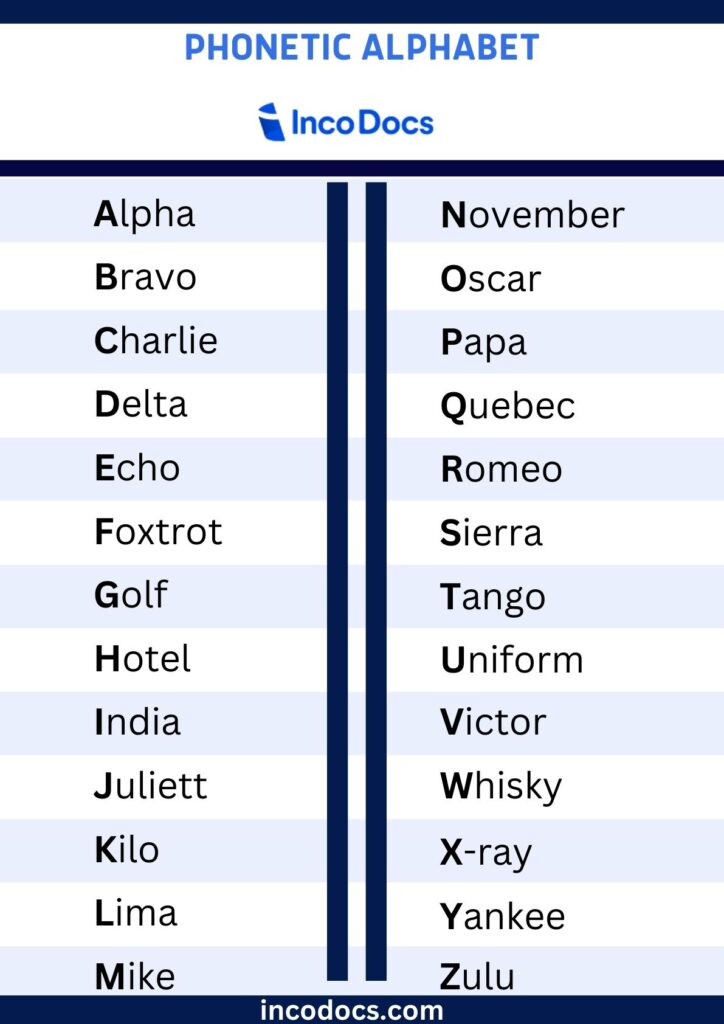
Artikel
18
januari
Alpha, Bravo, Charlie code: the NATO Phonetic Alphabet
The NATO Phonetic Alphabet is a key tool for clear communication. It uses special words to represent each letter of the alphabet. This helps avoid confusion, especially in noisy or unclear situations. This is used worldwide in aviation, shipping, and other areas and is also known as the Alpha Bravo Charlie phonetic alphabet. It’s a simple yet powerful way to make sure everyone understands each letter correctly.
Decoding the 26 Code Words: Structure and Pronunciation
In the Phonetic Alphabet, each letter has a unique code word. These words are chosen to sound different from each other. This reduces mistakes when speaking over radio or phone. The alphabet starts with ‘Alpha’ for ‘A’ and ends with ‘Zulu’ for ‘Z’. Each word is pronounced in a clear way. This helps people from different places understand each other. Learning these words and their correct pronunciations is easy and useful. This section will guide you through each of the 26 code words.
| Symbol/Letter | Code Word | Pronunciation |
|---|---|---|
| A | Alpha | AL-fah |
| B | Bravo | BRAH-voh |
| C | Charlie | CHAR-lee |
| D | Delta | DELL-tah |
| E | Echo | ECK-oh |
| F | Foxtrot | FOKS-trot |
| G | Golf | Golf |
| H | Hotel | hoh-TELL |
| I | India | IN-dee-ah |
| J | Juliett | JEW-lee-ett |
| K | Kilo | KEY-loh |
| L | Lima | LEE-mah |
| M | Mike | Mike |
| N | November | no-VEM-ber |
| O | Oscar | OSS-cah |
| P | Papa | pah-PAH |
| Q | Quebec | keh-BECK |
| R | Romeo | ROW-me-oh |
| S | Sierra | see-AIR-rah |
| T | Tango | TANG-go |
| U | Uniform | YOU-nee-form |
| V | Victor | VIK-tah |
| W | Whiskey | WISS-key |
| X | X-ray | ECKS-ray |
| Y | Yankee | YANG-key |
| Z | Zulu | ZOO-loo |
The Phonetic Alphabet in Action: Uses and Applications in trade
In trade, the Phonetic Alphabet streamlines operations. It’s crucial for international business, ensuring accurate data exchange. When dealing with shipping documentation, product codes or tracking numbers, it minimizes mistakes. In global logistics, it clarifies port names and shipping details. This is also essential in customer service, aiding in spelling out critical information. Overall, it enhances efficiency and accuracy in global trade communication.
Setting the Global Standard: ICAO and IATA’s Role in Phonetic Alphabet
The ICAO (International Civil Aviation Organization) standardized the Phonetic Alphabet in 1951. This was crucial for aviation safety. It ensures that pilots and air traffic controllers worldwide communicate clearly. The code words reduces misunderstandings in radio transmissions, especially in emergency situations.
The IATA (International Air Transport Association) also adopted this method. It’s used for airline ticketing, baggage tags, and flight identifiers. This helps avoid errors in handling passenger information and cargo. In global trade, it’s vital for tracking shipments and coordinating international flights.
The IMO (International Maritime Organization) uses this alphabet as well. It’s helpful for ships to communicate clearly, which is important for safety on the water. This shows that the alphabet is used not just in the air, but also at sea, making it a key tool in worldwide transport and trade.
The Birth and Evolution of the Phonetic Alphabet: From Able Baker to NATO
The Phonetic Alphabet has a rich history. It started before NATO adopted it. In the 1920s, the first version was used in aviation. It had words like ‘Able’ for ‘A’ and ‘Baker’ for ‘B’. This early version helped pilots and air traffic control talk clearly.
After World War II, the need for a universal system grew. Different countries used different alphabets. This caused confusion in international communication.
In 1951, the ICAO created a new alphabet. They tested many words to find the clearest ones. This led to the alphabet we know today, with ‘Alpha’ for ‘A’, ‘Bravo’ for ‘B’, and so on.
NATO started using this in the 1956. It became a global standard for clear communication. Today, it’s used not just in the military, but in many areas of trade and transport.

FAQ
What is the nato phonetic alphabet?
The NATO Phonetic Alphabet, also known as the International Radiotelephony Spelling Alphabet and Alpha Bravo Charlie phonetic alphabet, is a spelling alphabet used by the ICAO. NATO, and the International Telecommunication Union to ensure clear communication over radio and telephone lines. It assigns code words to the 26 letters of the English alphabet – Alpha, Bravo, Charlie, Delta, and so on.
When was the NATO alphabet adopted and why?
The NATO Phonetic Alphabet was adopted in 1956 to replace the previous “Able Baker” Alphabet. There was a need for a single universal alphabet that could be used by all member states of the ICAO and the NATO. The reason for adopting a new spelling alphabet was to eliminate any confusion that could be caused by poor communication, especially in military and civil aviation tasks.
Can you give an example of how the phonetic alphabet is used?
To spell the word “Kilo” which is used for the letter ‘K’, one would say “Kilo, India, Lima, Oscar”. It can also be used to clearly communicate number-letter combinations over noisy channels.
Are there any other versions of phonetic alphabets?
Yes, there are several phonetic alphabets but the NATO Phonetic Alphabet is the most widely recognized and used. It is known as the International Phonetic Alphabet and also as the military alphabet. Prior the NATO’s adoption, the “Able Baker” was used which was produced by the International Air Transport Association.
How does the NATO alphabet relate to the ICAO phonetic alphabet?
The NATO Phonetic Alphabet and the ICAO Phonetic Alphabet are actually the same thing. The code words were adopted by the International Civil Aviation Organization (ICAO) as the standard phonetic alphabet for aviation use and are now used universally in radio communication.
What’s the purpose of the NATO Phonetic alphabet?
It is used for clear and effective communication between personnel, especially in situations where misunderstandings could lead to significant consequences. It is used often in circumstances where clarity in communication is of utmost importance.
What's your reaction ?
Follow us on Social Media
Some Categories
Recent posts

July 27, 2024
Nieuwe kabinetsvisie: samen sterker tegen cyberdreigingen

July 24, 2024
Navigating AI Implementation: Try these strategies to overcome resistance.

July 24, 2024
Sick Leave Policy Netherlands Guidance for HR and Entrepreneur.

July 24, 2024
CSRD Reporting: Mandatory Reporting on Corporate Sustainability.

July 24, 2024
Training Budget: Investing in Employee Development.

 Inloggen
Inloggen
 Registreren
Registreren






Comments (0)
No reviews found
Add Comment